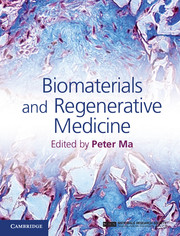Book contents
- Frontmatter
- Contents
- List of contributors
- Preface
- Part I Introduction to stem cells and regenerative medicine
- Part II Porous scaffolds for regenerative medicine
- Part III Hydrogel scaffolds for regenerative medicine
- Part IV Biological factor delivery
- 20 Growth factor delivery on scaffolds
- 21 Gene delivery for periodontal regeneration
- 22 Endogenous stem/progenitor cell recruitment for tissue regeneration
- 23 Affinity-based delivery systems
- 24 DNA delivery for regeneration
- Part V Animal models and clinical applications
- Index
- References
24 - DNA delivery for regeneration
from Part IV - Biological factor delivery
Published online by Cambridge University Press: 05 February 2015
- Frontmatter
- Contents
- List of contributors
- Preface
- Part I Introduction to stem cells and regenerative medicine
- Part II Porous scaffolds for regenerative medicine
- Part III Hydrogel scaffolds for regenerative medicine
- Part IV Biological factor delivery
- 20 Growth factor delivery on scaffolds
- 21 Gene delivery for periodontal regeneration
- 22 Endogenous stem/progenitor cell recruitment for tissue regeneration
- 23 Affinity-based delivery systems
- 24 DNA delivery for regeneration
- Part V Animal models and clinical applications
- Index
- References
Summary
Introduction
The delivery of nucleic acids is a powerful technique to regulate cellular processes that has profound implications for regenerative medicine. Nucleic acid delivery is most widely thought of as delivery of a gene to induce expression of a specific factor. This approach is highly versatile, insofar as it can readily target secreted factors (e.g. growth factors), membranous proteins (e.g. receptors), or intracellular proteins (e.g. transcription factors). Expression can potentially be modulated through the promoter, with control provided by soluble, inductive factors, or be restricted to specific cell populations. The alternative to delivering nucleic acids to induce expression of target genes is to reduce or block expression. The discovery of RNA interference (RNAi) has identified a powerful mechanism for nucleic acid delivery to catalyze the degradation of target mRNA. Similarly, oligonucleotides can bind to a complementary strand of mRNA (antisense) to terminate translation or act as decoys that bind to transcription factors and limit their ability to influence transcription. The delivery of nucleic acids has the potential to either promote or inhibit virtually any cell process; however, a major challenge to capitalizing on this potential lies in the need for effective delivery systems.
- Type
- Chapter
- Information
- Biomaterials and Regenerative Medicine , pp. 431 - 446Publisher: Cambridge University PressPrint publication year: 2014
References
- 1
- Cited by



